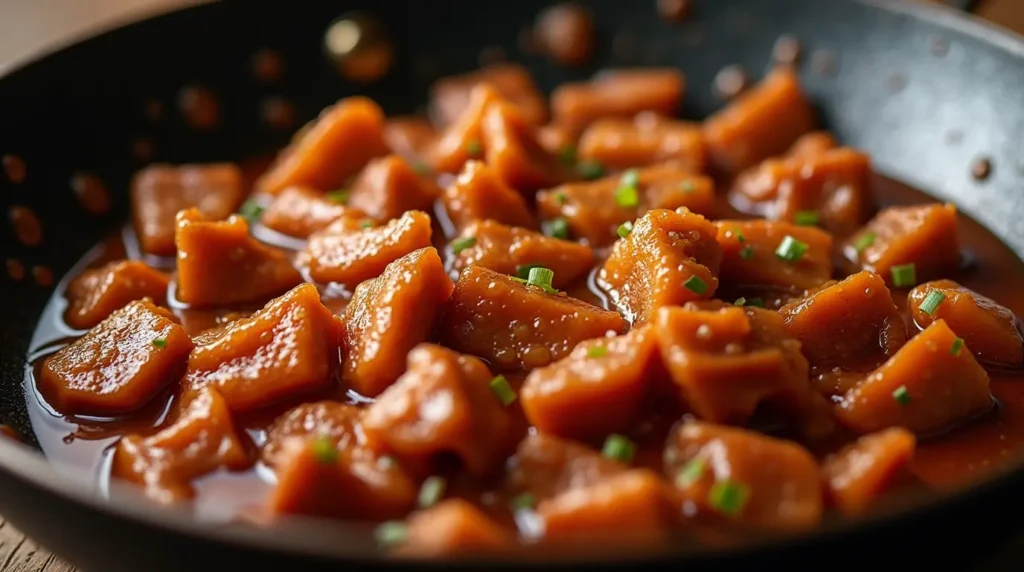Table of contents
- Introduction to Beijing Beef Sauce
- Key Ingredients in Beijing Beef Sauce
- How to Make Authentic Beijing Beef Sauce
- Variations of Beijing Beef Sauce
- Pairing Beijing Beef Sauce with Other Dishes
- Common Problems and Solutions When Making Beijing Beef Sauce
- People also ask (PAA)
- Conclusion: Mastering the Perfect Beijing Beef Sauce
When you think of a Beijing Beef Recipe, the first thing that comes to mind is the deliciously sticky and flavorful sauce that ties the dish together. But what exactly is Beijing Beef Sauce made of? This sweet, tangy, and savory sauce combines simple ingredients like soy sauce, sugar, and vinegar to create its signature taste. Let’s dive in and explore what makes this sauce so special and how you can make it at home!
Introduction to Beijing Beef Sauce
The Role of Sauce in Beijing Beef
Have you ever noticed how the sauce in Beijing Beef clings to each crispy piece of beef like a luxurious coat? That’s no accident! The sauce plays a pivotal role in the dish, providing not just flavor but also texture. It elevates the crispy beef strips with a glossy finish and ensures every bite is packed with bold, vibrant tastes.
“A great sauce doesn’t just complement a dish it transforms it into something unforgettable.”
Why the Sauce is the Star of the Dish
Sure, crispy beef is delicious on its own, but without the sauce, it’s like a melody without harmony. The sauce is what gives Beijing Beef its signature taste: a dance of flavors that’s sweet, tangy, and savory with a whisper of heat. It’s this complexity that keeps you coming back for more.
Let’s face it when you think of Beijing Beef, it’s the sauce you’re really craving. It’s no wonder many chefs say the sauce is where the magic happens.
Key Ingredients in Beijing Beef Sauce
Now that we’ve established why the sauce is so important, let’s break down the ingredients that make it shine.
Soy Sauce: The Umami Backbone
Soy sauce is the cornerstone of Beijing Beef Sauce. It adds depth, saltiness, and that unmistakable umami flavor. Light soy sauce is typically used for its delicate taste, while dark soy sauce can provide a richer color and slightly sweeter undertone.
Sugar: Adding Sweetness to Balance
Sugar plays a crucial role in balancing out the tanginess and saltiness of the sauce. White sugar is commonly used, but brown sugar or honey can add an extra layer of complexity with a hint of caramel-like sweetness.
Vinegar: The Tangy Element
Tanginess is what gives Beijing Beef Sauce its zing! Rice vinegar is the traditional choice, offering a mild, slightly sweet acidity that complements the other ingredients beautifully. If you don’t have rice vinegar, apple cider vinegar can work as a substitute.
Ketchup: The Secret Ingredient for Color and Flavor
Surprised? Ketchup is the secret weapon in Beijing Beef Sauce. It adds sweetness, acidity, and a vibrant red hue that makes the dish visually appealing. Plus, it helps create the thick, sticky texture that clings to the beef.
“Ketchup in a Chinese dish? It might sound unconventional, but trust me—it’s the unsung hero of Beijing Beef Sauce!”
Garlic and Ginger: Essential Aromatics
No Beijing Beef Sauce would be complete without garlic and ginger. These two aromatics provide a fresh, zesty kick that ties all the flavors together. Sautéing them releases their natural oils, enhancing the sauce’s depth and aroma.
How to Make Authentic Beijing Beef Sauce
Making Beijing Beef Sauce at home is easier than you might think. Let’s walk through the steps to achieve that perfect balance of flavors and consistency.
Step-by-Step Guide to Making the Sauce

- Prepare the Ingredients: Gather soy sauce, sugar, rice vinegar, ketchup, garlic, and ginger.
- Sauté the Aromatics: Heat a tablespoon of oil in a pan and sauté minced garlic and ginger until fragrant.
- Mix the Sauce Base: In a bowl, whisk together soy sauce, sugar, vinegar, and ketchup until smooth.
- Combine and Simmer: Pour the sauce mixture into the pan with the aromatics. Bring to a simmer, stirring constantly.
- Thicken with Cornstarch: Add a cornstarch slurry (1 tablespoon cornstarch mixed with 2 tablespoons water) to the sauce. Stir until it thickens to a glossy consistency.
Common Substitutions for Ingredients
- No Rice Vinegar? Try apple cider vinegar or white vinegar with a pinch of sugar.
- Low on Soy Sauce? Tamari or coconut aminos work as gluten-free alternatives.
- Out of Ketchup? Use tomato paste mixed with a little sugar and vinegar.
Tips for Achieving the Perfect Consistency
The secret to a great Beijing Beef Sauce is its glossy, sticky texture. To achieve this:
- Stir continuously when adding the cornstarch slurry to avoid lumps.
- If the sauce is too thick, add a splash of water to thin it out.
- Let the sauce simmer for a minute or two after thickening to fully develop its flavors.
“The beauty of Beijing Beef Sauce lies in its balance. It’s a symphony of flavors where no one note overpowers the others.”
Variations of Beijing Beef Sauce
One of the best things about Beijing Beef Sauce is its versatility. You can tweak it to suit your dietary preferences or flavor cravings while still retaining its signature taste.
Healthier Alternatives: Low-Sugar Sauce
Watching your sugar intake? No problem! Here’s how you can make a healthier version of Beijing Beef Sauce:
- Swap Sugar with Honey: Honey adds natural sweetness with fewer processed sugars.
- Use Stevia or Monk Fruit Sweetener: These zero-calorie sweeteners are great for cutting down sugar without sacrificing sweetness.
- Go Light on Soy Sauce: Opt for a low-sodium soy sauce to keep the salt levels in check.
Vegan and Gluten-Free Sauce Options
If you’re catering to dietary restrictions, here are some easy swaps:
- Soy-Free Option: Replace soy sauce with coconut aminos for a vegan and gluten-free alternative.
- Thickener: Use arrowroot powder instead of cornstarch for a grain-free thickening agent.
- Ketchup Substitute: Look for vegan ketchup or make your own using tomato paste and vinegar.
Spicy Beijing Beef Sauce for Heat Lovers
If you like a little heat in your food, consider these spicy upgrades:
- Add red chili flakes or Sriracha to the sauce for a gentle kick.
- For something bolder, mix in chili garlic paste or freshly chopped Thai chilies.
- A dash of hot sesame oil can also enhance both the spice and the aroma.
“Customizing your Beijing Beef Sauce is like creating your own masterpiece it’s all about making it uniquely yours!”
Pairing Beijing Beef Sauce with Other Dishes
While Beijing Beef Sauce is traditionally paired with crispy beef strips, its versatility makes it perfect for other dishes too. Let’s explore some options.
Other Recipes That Work with Beijing Beef Sauce
- Crispy Chicken Stir-Fry: Swap beef with chicken strips for a leaner yet equally delicious option.
- Vegetarian Delight: Toss the sauce with crispy tofu or roasted cauliflower for a plant-based twist.
- Seafood Magic: Drizzle the sauce over stir-fried shrimp or seared salmon for a tangy-sweet seafood treat.
Serving Suggestions and Presentation Tips
The way you serve Beijing Beef Sauce can make a big difference.
- Over Steamed Rice: Let the sauce seep into the rice for a satisfying, flavor-packed meal.
- With Noodles: Toss the sauce with chow mein or lo mein for a hearty noodle dish.
- On a Platter: Arrange crispy beef strips on a platter, pour the sauce over the top, and garnish with sesame seeds and green onions for a stunning presentation.
“Presentation is key because we eat with our eyes first!”
Common Problems and Solutions When Making Beijing Beef Sauce
Even the best cooks run into trouble sometimes. Here are solutions to some common issues when making Beijing Beef Sauce.
Sauce Too Thin or Too Thick? Fixing Consistency Issues
- Too Thin?
- Add more cornstarch slurry (1 teaspoon cornstarch mixed with 2 teaspoons water) and stir over low heat until the sauce thickens.
- Make sure to simmer the sauce longer to allow the liquid to reduce.
- Too Thick?
- Stir in small amounts of water, chicken broth, or even a splash of soy sauce to thin it out.
- Heat gently and keep stirring to maintain the glossy texture.
Balancing Flavors: Too Sweet, Salty, or Tangy?
- Too Sweet? Add a dash of vinegar or more soy sauce to counterbalance the sweetness.
- Too Salty? Stir in a bit of sugar, honey, or a squeeze of lime juice to soften the saltiness.
- Too Tangy? Add a small amount of sugar or ketchup to round out the sharpness.
Storing and Reusing Leftover Sauce
If you’ve made extra sauce, don’t let it go to waste!
- Storing: Pour the sauce into an airtight container and refrigerate it for up to 5 days.
- Reusing: Warm the sauce gently in a pan over low heat, adding a splash of water if it has thickened too much in the fridge.
- Freezing: For longer storage, freeze the sauce in ice cube trays for up to 3 months. Simply thaw and use as needed.
“In cooking, there are no failures only opportunities to adjust and improve!”
You can also click here: beijing beef recipe
People also ask (PAA)
How to make beef soft like Chinese restaurants?
Is Beijing beef and Mongolian beef the same thing?
While both dishes feature beef as the star ingredient, they’re quite different. Beijing Beef is known for its crispy, battered beef and vibrant sweet-and-sour flavors, making it a favorite in Chinese-American cuisine. Mongolian Beef, however, is a classic stir-fry dish with tender beef slices in a mildly sweet and savory sauce, garnished with green onions. The texture, sauce, and preparation methods set them apart.
Why is Beijing beef so good?
The magic of Beijing Beef lies in its versatility and flavor explosion. The sauce is both nostalgic and addictive, with its perfect balance of sweetness and tang. The beef, fried to golden perfection, absorbs the sauce while maintaining its crunch. Whether you pair it with rice or noodles, it’s the ultimate comfort food that’s hard to put down.
“Planning ahead with pre-made sauce means dinner can be ready in minutes it’s like having a personal chef in your fridge!”
Conclusion: Mastering the Perfect Beijing Beef Sauce
Congratulations! You’ve now unlocked the secrets to creating the perfect Beijing Beef Sauce at home. From understanding its essential ingredients to learning how to troubleshoot common problems, you’re ready to make this beloved sauce with confidence. Whether you stick to the traditional recipe or experiment with variations, your version of Beijing Beef Sauce is guaranteed to impress.
Here’s a quick recap of what we’ve covered:
- The essential ingredients, like soy sauce, sugar, vinegar, and ketchup, that give the sauce its signature flavor.
- Step-by-step instructions to make the sauce with the perfect consistency.
- Creative variations for health-conscious, vegan, or spice-loving cooks.
- Solutions to common problems, like balancing flavors and fixing consistency issues.
“Good food is all about balance, and Beijing Beef Sauce is a perfect example of flavors working in harmony. It’s a small effort for a big reward!”
Now it’s time to bring your sauce-making skills to life! Whether you’re whipping up crispy beef or experimenting with other dishes, this sauce will take your cooking to the next level. Happy cooking!

